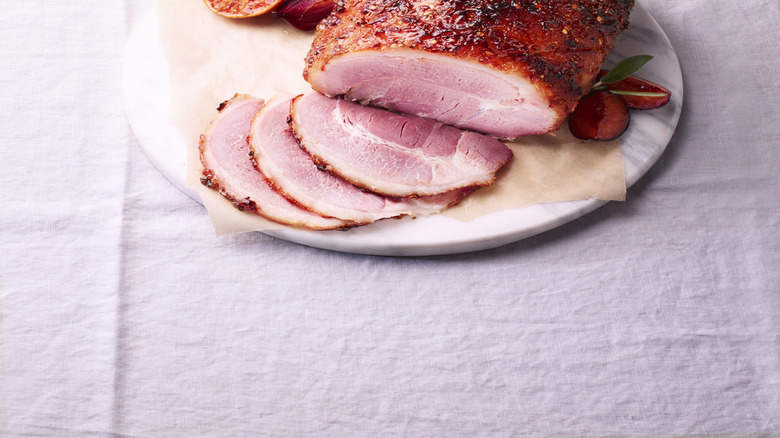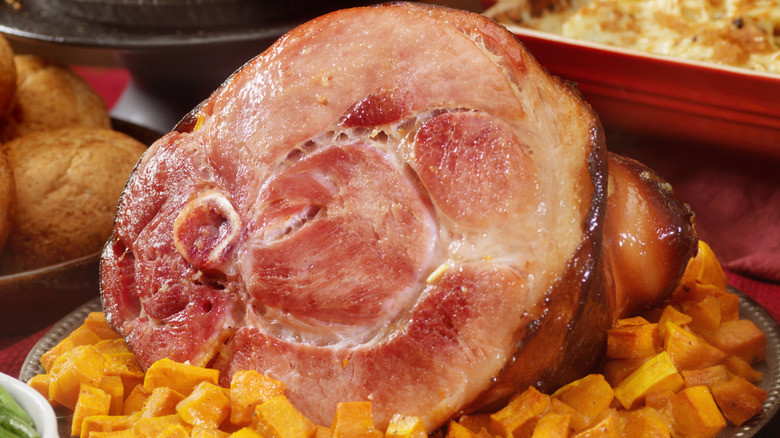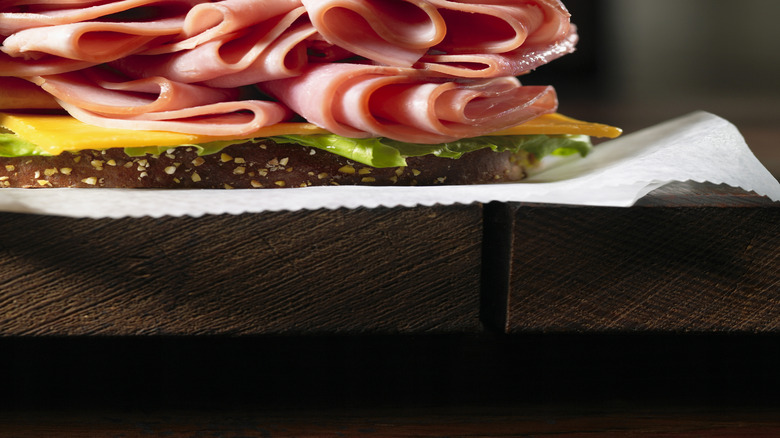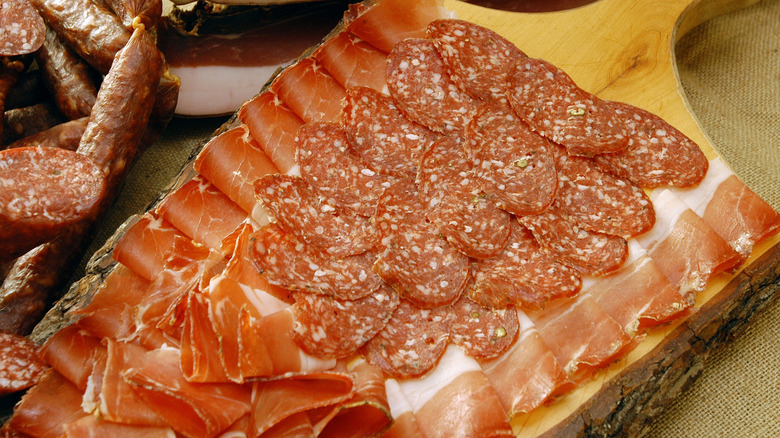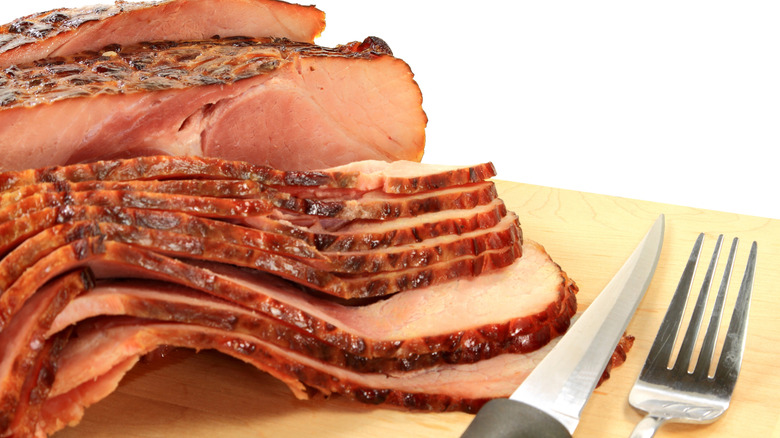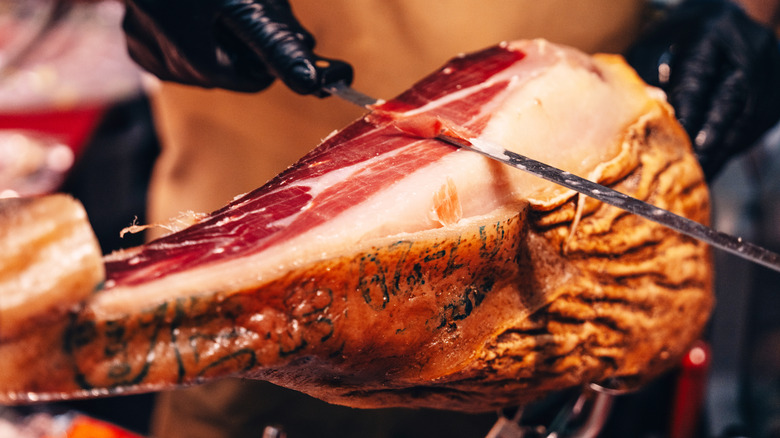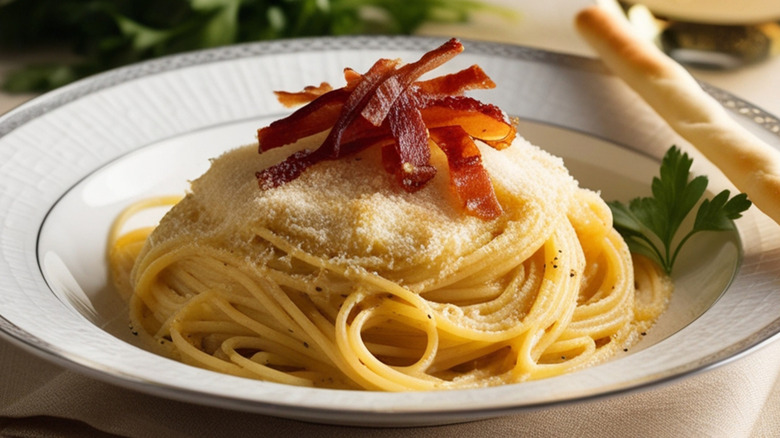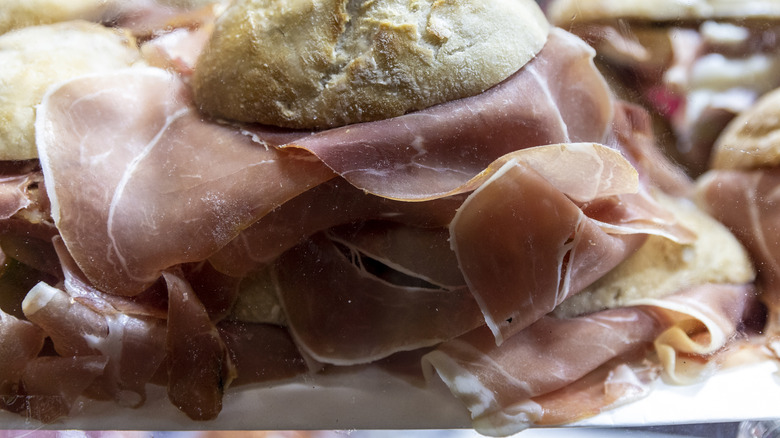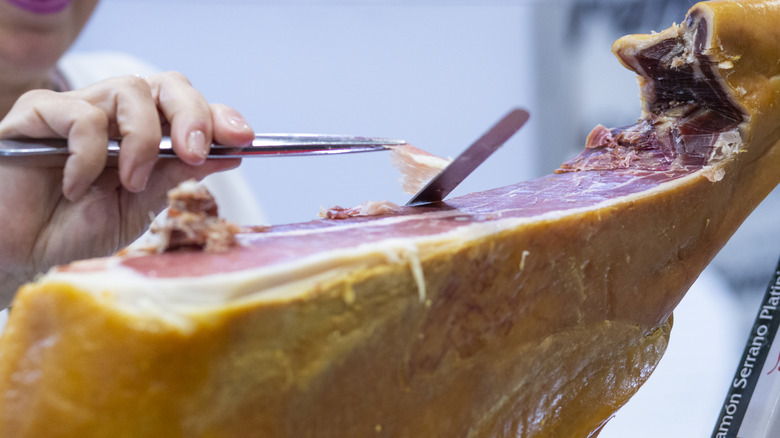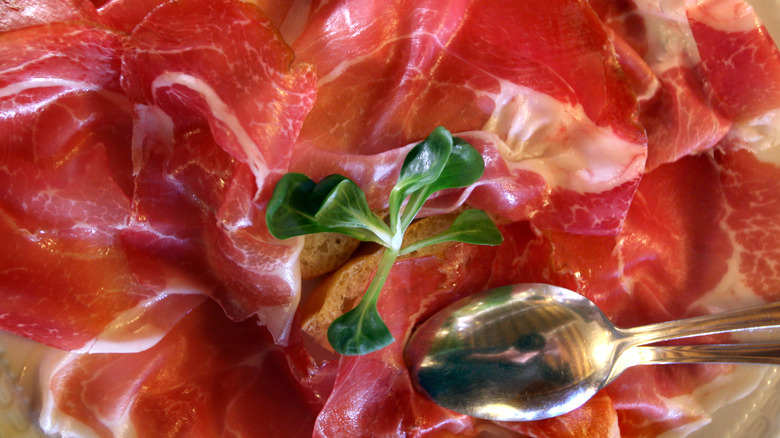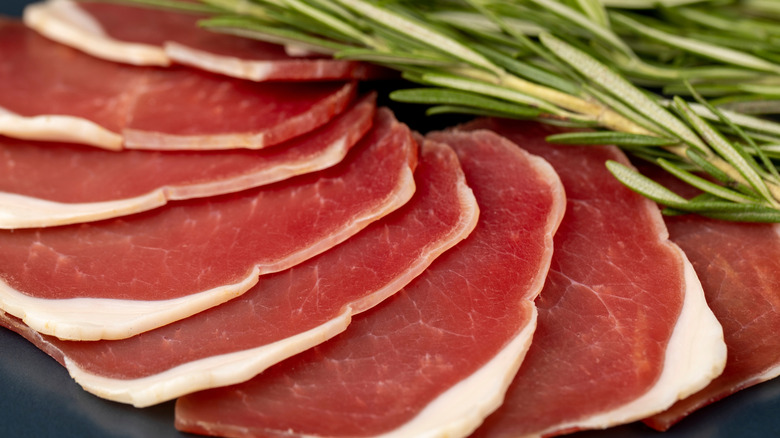The Ultimate Guide To Different Deli Hams
When it comes to deli meats, few are more versatile and delicious than ham. It is a classic deli product for a reason, thanks to its salty, savory flavor that adds richness to whatever meal it's a part of. Whether you're building the perfect sandwich, crafting a charcuterie board, or simply looking for a savory snack, this deli meat comes in a wide range of flavors, styles, and textures that are well suited for a multitude of ham recipes worth trying. There's a world of variety among deli hams worth exploring, each bringing its own unique history and culinary possibilities.
From classic Black Forest ham to indulgent jamón Ibérico to traditional honey glazed ham, each style can serve a different purpose depending on what kind of deli meat experience you're looking for. We have put together the ultimate guide to different types of deli hams so you can choose the perfect one for your next meal. Knowing what makes each of these hams special should help you decide which one to try next!
Black Forest ham
Did you know that Black Forest ham originates from an actual Black Forest? The Schwarzwald forest, also known as The Black Forest, is located in southwest Germany and is the namesake of one of the most well-known types of ham worldwide. What sets Black Forest ham apart is its distinct smoky flavor, achieved through a traditional cold-smoking process over pine wood. The ham is also coated with a seasoning of garlic, juniper, salt, coriander, and other spices, which add a savory depth.
The ham's dark exterior is iconic, created by curing the meat for up to three months, which also makes it incredibly tender and moist. Black Forest ham is a favorite for sandwiches due to its strong, smoky notes that stand out without overpowering other ingredients. However, it is versatile enough to be used in nearly any recipe that calls for ham. Whether it's on a charcuterie board, chopped up inside a quiche, or tucked into a sandwich with Swiss cheese, this ham adds a rustic, bold, and hearty flavor to every dish.
Honey ham
For those with a bit of a sweet tooth and a penchant for the classics, honey ham is a perfect choice. As the name suggests, this ham is glazed with honey before baking, which gives it a subtle sweetness that complements the meat's natural saltiness. The combination of sweet and savory flavors makes honey ham particularly popular during the holidays, when it is often served as a centerpiece for large family meals.
However, honey ham is not just for special occasions. It also works well when thinly sliced for sandwiches, when chopped for salads, or even when diced to be included in breakfast casseroles or frittatas. The tenderness, the moist interior, and the balanced flavor make this variety appealing for both kids and adults alike. If you're looking for a deli option that is sure to please almost any palate and will add a hint of sweetness to your meal, honey ham is a solid go-to.
Off-the-bone ham
Off-the-bone ham is exactly what it sounds like: ham that has been expertly carved directly from the bone. This process typically results in a ham that has a more intense, natural flavor because it retains more of its juices during cooking. Off-the-bone ham is often considered superior in texture and taste to most prepackaged deli hams because it's fresher and less processed. Grocery store delis can slice this ham upon request for customers who are looking to get that freshly baked taste without the hassle of cooking an entire ham at home.
In addition to its distinct flavor, off-the-bone ham stands out for its many uses. It can be incorporated into a wide array of dishes, from breakfast omelets to a pizza topping and, of course, for sandwiches. If you do have a bone-in ham at home, don't forget that the bone itself can be used to make stock for flavorful collard greens or hearty soups. Off-the-bone ham is a deli counter staple for good reason — its flavor and texture are consistently top-notch, making it a crowd-pleaser.
Virginia ham (country ham)
Virginia ham, also referred to as country ham, is a Southern favorite known for its dry-cured and salty flavor. This style of ham originated around 1944 in the rural parts of states like Virginia, Kentucky, Tennessee, Georgia, and the Carolinas. However, ham that is not from these regions can also be classified as Virginia or country ham as long as it is prepared in accordance to the variety's specifications. This ham typically takes longer to cure, giving it a firm texture and bold taste. The curing process involves coating the ham with salt and sometimes sugar, then allowing it to age for at least six months and sometimes for over a year. It is often smoked over oak, hickory, walnut, or apple wood, giving it a smoky taste that is traditionally milder than Black Forest.
Virginia ham is a bit saltier than other hams, which makes it perfect for pairing with sweeter sides like biscuits or a drizzle of honey. It's often served thinly sliced to offset its intense flavor. While it may be an acquired taste for some, fans of salty, cured meats will appreciate its robust, unique flavor.
Speck
Hailing from the northeast regions of Italy near the Dolomite mountains, speck is a type of ham that blends the best of both worlds — it is cured like prosciutto but smoked like Black Forest ham. This Italian-style ham is dry-cured and comes from the deboned hind thigh of pigs that are fed and raised in particular ways. Speck is lightly smoked outdoors, giving it a delicate, smoky flavor. Additionally, speck is typically seasoned with a variety of spices, including bay leaves, juniper berries, salt, and pepper.
To be categorized as truly authentic speck, or Speck Alto Adige IGP, the package will have a certain label that guarantees the meat's authenticity. To ensure quality, the meat is inspected by government agencies. As of now, there are only about 30 authorized producers of authentic Speck Alto Adige IGP in the world.
Speck is a bit firmer than other hams, making it ideal for thin slicing. Its versatility makes it perfect for sandwiches, charcuterie boards, and even cooking. The rich flavor adds a depth that works well with hearty cheeses, fresh vegetables, or pasta dishes.
Prosciutto
Perhaps one of the most famous deli hams, prosciutto is a delicacy from Italy that is beloved for its silky, melt-in-your-mouth texture and serious depth of flavor. Made from the hind leg of a pig, prosciutto is seasoned with salt and dry-cured without nitrates for anywhere from nine months to up to three years, giving it a one-of-a-kind sweetness. Generally, prosciutto is flavored with nothing other than salt, although some varieties include seasonings such as juniper, garlic, black pepper, or rosemary.
In Italy, prosciutto is referred to as prosciutto crudo, which translates to "raw ham." As such, it is no wonder that this style of ham is best enjoyed uncooked. Prosciutto is often found on a charcuterie board, wrapped around fruit like melon or figs that can balance out its salty and rich flavor. It's also popular in sandwiches and wraps and as a pizza topping. You may even find it wrapped around asparagus or other veggies for a delightful appetizer. Its paper-thin slices are packed with flavor, making it a favorite for those who appreciate a more refined, less smoky ham experience.
Smoked ham
There are many varieties of ham on this list that are smoked as a part of the preparation method. However, when most people think of smoked ham, they imagine classic varieties like hickory smoked ham. Generally, smoked hams are iconic varieties known for their deep, woodsy flavors. The smoking process, which occurs after the ham has been cured, is often done with hickory or apple wood. Smoking infuses the ham with a bold, wood-fired taste that pairs well with a wide range of dishes. The cooking process results in moist, tender ham with an almost caramelized outer layer. Some hams on the market are labeled as smoked but instead use liquid smoke additives, so be on the lookout for details on packaging labels that set true smoked ham apart.
This type of ham is often enjoyed thickly sliced in hearty sandwiches, like a classic ham and cheese, but it can also be used in recipes like delicate quiches or slowly simmered soups. The strong flavor of smoked ham can stand up to bold ingredients like mustard or sharp cheeses, making it a versatile addition to any meal.
Jamón Ibérico
Jamón Ibérico is considered the crown jewel of deli hams and for good reason. This Spanish ham comes from the black Iberian pig, which is native to Spain and Portugal. What makes jamón Ibérico so unique is the pigs.
There are three main varieties of jamón Ibérico. The first, known simply as jamón Ibérico, is made from Ibérico pigs that are raised indoors and are fed only hay. The next highest quality version is jamón Ibérico Cebo de Campo. These pigs are fed a blend of hay and acorns, giving the meat a different flavor. The premiere version is known as jamón Ibérico de Bellota. This variety is renown for its flavor thanks to the fact that the pigs survive exclusively on acorns.
Dry-cured and aged for between 12 months and up to 48 months, jamón Ibérico is prized for its melt-in-your-mouth texture and rich, complex taste. It's typically served in ultra-thin slices, often as part of a tapas spread or enjoyed simply on its own. Due to its rarity and the meticulous process involved in making it, it's one of the most expensive hams you can find. For the best experience, it's recommended that you only purchase jamón Ibérico that has been hand-sliced, as carvers spend years learning the ideal way to slice the meat to perfectly distribute the fat among each piece.
Pancetta
Often compared to bacon but truly in a league of its own, pancetta is an Italian cured meat ideal for cooking. Similar to bacon, pancetta is made from pork belly. Unlike bacon, pancetta is not smoked, so its flavor is more subtle and slightly salty. Compared to other hams, which are usually from the hind leg of the pig, pancetta has a different texture and more concentrated pork flavor.
Pancetta is typically dry or wet cured with seasonings like salt, sugar, black pepper, nutmeg, cinnamon, fennel, and cloves and aged for months. Slabs of the meat are rolled into logs and then sliced to order at your local deli. Pancetta is often also sold pre-packaged in cubes, which are ideal for sautéing. No matter how you choose to slice or dice it, pancetta adds a savory element to dishes like pasta carbonara or risotto. Its rich flavor and fatty texture also make it a perfect addition to soups or stews. While it's typically not eaten on its own like other hams, pancetta's versatility in the kitchen makes it an essential for many home chefs.
Bauernschinken (German ham)
Bauernschinken, which translates to "farmers' ham" in German, is a flat, smoked, and air-dried ham that hails from the alpine regions of Germany and Austria. This variety of ham can be made either bone-in or without the bone. Bauernschinken ham is usually seasoned with juniper berries, pepper, and garlic, giving it a robust flavor profile. It is usually smoked over beechwood or juniper branches that impart a mild smokiness without overpowering the meat's natural sweetness.
This ham is typically enjoyed thinly sliced as part of a cold platter, often alongside cheeses, pickles, and hearty bread. German meals such as asparagus dinners, warm or cold noodle dishes, and belegte Brötchen (German filled rolls or sandwiches) are also all classic uses of this style of ham. The texture and complex flavor of Bauernschinken make it a favorite for rustic, mountain-inspired meals, and its uniqueness lies in its balanced flavor and aroma.
Capocollo
When you think of all the high-quality deli meats out there, there are few that are as iconic as capocollo. Also referred to as coppa, this meat is a traditional Italian deli product made from the neck and shoulder of the pig. The meat is dry-cured and seasoned with a blend of pungent spices such as black pepper, paprika, coriander, aniseed, or fennel for a bold flavor profile. The meat is aged for several months.
Capocollo has a more robust taste than other sausage-style meats like prosciutto due to the marbling of fat throughout the meat. Capocollo has a 30% fat content, making it particularly luxurious and creamier than meats like salami. Similar to other dry-cured meats, capocollo is often served thinly sliced for charcuterie boards, antipasto platters, or sandwiches. Capocollo's spicier varieties are also a great addition to pasta dishes or pizzas, where its strong flavor can shine through.
Jamón serrano
Jamón serrano, often referred to as the mountain ham of Spain, is a dry-cured ham made from white pigs. Breeds usually used for jamón serrano include Landrace or Duroc. The pigs are typically raised indoors and exclusively fed a blend of grains to enhance the flavor profile. Often compared to jamón Ibérico, serrano is different in that it is more fatty. This ham is similar to prosciutto, as it is best serve thinly sliced, and has a good amount of marbling. However, jamón Ibérico has a slightly firmer texture and a more intense flavor. The process of curing jamón serrano lasts for at least a year but can be extended up to 18 months. This curing helps develop the ham's trademark deep and savory taste.
Serrano ham is typically enjoyed uncooked, either on its own or paired with crusty bread and olives. It's also commonly used in Spanish cuisine, from tapas to simple sandwiches. Jamón serrano offers a more affordable alternative to the luxurious jamón Ibérico but still delivers a delicious, authentic Spanish ham experience.
Culatello
Culatello is a prized Italian ham that originated near Parma in the Emilia-Romagna region of Italy. This meat is made from the heart of the pig's hind leg, specifically the rear to the inner thigh. What sets culatello apart from other meats is its aging process. The meat is first seasoned with black pepper, garlic, and a very large amount of salt before being wrapped in a cleaned pig bladder. The meat is then hung in a dark, humid cellar, allowing the ham's casing to become covered with mold. This helps develop a uniquely tender texture and a complex flavor that's both sweet and savory. The process is so unique and labor intensive that there are only 23 producers in nine towns in Italy certified to make authentic culatello.
Due to its rarity and extensive production process, culatello is considered a luxury item with a fan base that includes some celebrities. Its delicate flavor makes it a perfect companion to aged cheeses and fine wines, and it is often served as part of a high-end charcuterie board.
Bayonne ham
Bayonne ham hails from the Basque region of western France and is known for its mild, sweet flavor. The ham is similar to prosciutto and is dry-cured. Also similar to prosciutto di Parma, Bayonne ham must come from the area it is named after in order to be considered authentic. The ham is cured with a large amount of salt that is exclusively taken from the Adour River basin. After a few months, the salt is rinsed off before the next part of the curing process begins. The meat rests in cold temperatures for another few months before being moved to a warm room for more curing. The entire process takes more than a year. Unlike some of the saltier hams on this list, Bayonne ham has a more subtle taste, making it highly versatile.
This ham variety is commonly used in salads, sandwiches, and quiches, or simply served thinly sliced as part of a charcuterie board. Bayonne ham is less smoky than other hams but still brings a rich flavor that can complement a variety of dishes.
Canadian bacon
Although often confused with other types of ham and even bacon itself, Canadian bacon is its own variety of cured pork. Compared to most ham, which usually comes from the leg and hind end of the pig, and bacon, which is typically made from the fatty belly of the pig, Canadian bacon is made from the loin. This gives the meat a leaner and slightly milder flavor compared with traditional ham or bacon. Another aspect that sets Canadian bacon apart is the curing process. This meat is wet-cured and smoked to get a specific flavor and texture.
Canadian bacon, which isn't even Canadian, comes precooked and ready to serve. It is a breakfast favorite, especially in dishes like eggs Benedict, where its lean, tender slices provide a perfect contrast to the richness of poached eggs and hollandaise sauce. It can also be enjoyed on pizzas, with salads, or in sandwiches. Thanks to its lower fat content and versatility, Canadian bacon is a go-to for those looking for a lighter but still flavorful deli meat.


